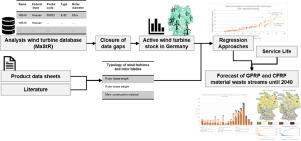Resources, Conservation and Recycling ( IF 13.2 ) Pub Date : 2021-05-26 , DOI: 10.1016/j.resconrec.2021.105667 Rebekka Volk , Christoph Stallkamp , Magnus Herbst , Frank Schultmann

|
Worldwide, wind turbine stocks are ageing and questions of reuse and recycling particularly of rotor blades become urgent. Especially, rising rotor blade wastes face lacking good recycling options and exact quantification is difficult due to information gaps on the rotor blade size, mass and exact material composition. In a combined approach, the expected rotor blade waste is quantified and localized on a national level for Germany until 2040. Fibre-reinforced plastics (FRP) from rotor blades are in focus and differentiated into two material classes: glass-fibre reinforced plastics (GFRP) and glass- and carbon-fibre reinforced plastics (GFRP/CFRP). The quantification approach is based on a national power plant stock database (Marktstammdatenregister) and regression models, combined with a power class-based estimation for missing datasets. As a result, between 325,726 and 429,525 t of waste from the GFRP material class and between 76,927 t and 211,721 t of waste from the GFRP/CFRP material class arise from obsolete rotor blades in Germany until 2040. This corresponds to a share of between 11% and 32% of wind turbines with GFRP/CFRP rotor blade material in Germany. For GFRP, waste peaks in 2021, 2035 and 2037 are expected with around 40,000 t of waste per year. For GFRP/CFRP, waste peaks in 2036 and 2037 will induce more than 20,000 t/a. Mostly affected federal states are Lower Saxony, Brandenburg, North Rhine-Westphalia and Schleswig-Holstein. The methods are applicable and transferable to other countries, particularly with ageing wind turbines fleets.
中文翻译:

到2040年,德国对转子叶片废物进行区域量化
在世界范围内,风力涡轮机库存正在老化,尤其是转子叶片的再利用和回收问题变得迫在眉睫。尤其是,上升的转子叶片废料面缺乏良好的回收选择,并且由于转子叶片尺寸,质量和确切材料组成方面的信息差距,很难进行准确定量。通过一种综合方法,对德国的预期转子叶片废物进行量化和局部化,直至2040年为止。德国着眼于转子叶片的纤维增强塑料(FRP),并将其分为两种材料类别:玻璃纤维增强塑料(GFRP) )以及玻璃纤维和碳纤维增强塑料(GFRP / CFRP)。量化方法基于国家电厂库存数据库(Marktstammdatenregister)和回归模型,并结合基于功率类的缺失数据集估算。结果,到2040年,德国已淘汰的转子叶片产生了325,726至429,525吨GFRP材料类别的废物,以及76,927吨至211,721 t GFRP / CFRP材料类别的废物。在德国使用GFRP / CFRP转子叶片材料的风力涡轮机中,有%和32%。对于GFRP,预计2021年,2035年和2037年将达到废物高峰,每年约有40,000吨废物。对于GFRP / CFRP,2036年和2037年的废物高峰将诱发超过20,000吨/年。受灾最严重的联邦州是下萨克森州,勃兰登堡州,北莱茵-威斯特法伦州和石勒苏益格-荷尔斯泰因州。该方法适用于其他国家,并可转让给其他国家,尤其是在老化的风力涡轮机机队中。截止到2040年,德国有721吨GFRP / CFRP材料产生的废物来自过时的转子叶片。这相当于德国使用GFRP / CFRP转子叶片材料的风力涡轮机的份额在11%至32%之间。对于GFRP,预计2021年,2035年和2037年将达到废物高峰,每年约有40,000吨废物。对于GFRP / CFRP,2036年和2037年的废物高峰将诱发超过20,000吨/年。受灾最严重的联邦州是下萨克森州,勃兰登堡州,北莱茵-威斯特法伦州和石勒苏益格-荷尔斯泰因州。该方法适用于其他国家,并可转让给其他国家,尤其是在老化的风力涡轮机机队中。截止到2040年,德国有721吨GFRP / CFRP材料产生的废物来自过时的转子叶片。这相当于德国使用GFRP / CFRP转子叶片材料的风力涡轮机的份额在11%至32%之间。对于GFRP,预计2021年,2035年和2037年将达到废物高峰,每年约有40,000吨废物。对于GFRP / CFRP,2036年和2037年的废物高峰将诱发超过20,000吨/年。受灾最严重的联邦州是下萨克森州,勃兰登堡州,北莱茵-威斯特法伦州和石勒苏益格-荷尔斯泰因州。该方法适用于其他国家,并可转让给其他国家,尤其是在老化的风力涡轮机机队中。预计2035年和2037年每年将产生约40,000吨废物。对于GFRP / CFRP,2036年和2037年的废物高峰将诱发超过20,000吨/年。受灾最严重的联邦州是下萨克森州,勃兰登堡州,北莱茵-威斯特法伦州和石勒苏益格-荷尔斯泰因州。该方法适用于其他国家,并可转让给其他国家,尤其是在老化的风力涡轮机机队中。预计2035年和2037年每年将产生约40,000吨废物。对于GFRP / CFRP,2036年和2037年的废物高峰将诱发超过20,000吨/年。受灾最严重的联邦州是下萨克森州,勃兰登堡州,北莱茵-威斯特法伦州和石勒苏益格-荷尔斯泰因州。该方法适用于其他国家,并可转让给其他国家,尤其是在老化的风力涡轮机机队中。



























 京公网安备 11010802027423号
京公网安备 11010802027423号